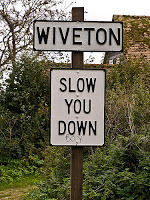Dontcha Know How Ter Write Dialects, Y'all?

Courtesy of yooperann at PhotoPin
Dialects and accents in fiction are a particular source of contention for me. One of the characters in my historical fiction is a Native American girl who speaks English as a second language. Critique partners and my own ears have told me that her speech needs work, so for literally months I've been thinking about the issue of how to write dialects and accents in a believable way. Then, while I was reading Maggie Stiefvater's THE RAVEN BOYS, I discovered some easy techniques to show the reader how the character sounds. First:
The voice was careful, masculine, and local; the vowels had all the edges sanded off.
The simplicity of this just kills me. Steifvater doesn't go into detail describing the individual sounds of the character's speech, the phonetics, how the sentences are put together. She succinctly tells how the words sound, then writes them the normal way, and the reader's brain fills in the rest. In this particular case, the story takes place in Virginia. If you're familiar with the way Virginians talk, then the "local" reference will immediately clue you in to how the speaker sounds. And if you're unfamiliar with the accent, you get a good feel for it with the description she gives of the vowels.
Here's another example of how you can describe someone's speech when you're referencing a known language or accent:
When he was uncertain about something, his Southern accent always made an appearance, and it was in evidence now.
Not only does this clue the reader in as to how the character speaks, but it also reveals his frame of mind. This is an excellent example of description that does more than just describe.
Here's one more sample, this time describing an elderly English gentleman's speech:
Without further preamble, Malory launched into a one-sided conversation about the weather, the historical society's past four meetings, and how frustrating his neighbor with the collie was. Gansey understood about three quarters of the monologue. After living in the UK for nearly a year, Gansey was good with accents, but Malory's was often difficult, due to a combination of slurring, chewing, extreme age, bad breeding, and a poor phone connection.

Courtesy of Gerry Balding
The conversation that follows doesn't include any hard-to-read pronunciations or truncated verbs (talkin', eatin', drivin', etc.). Malory's rambly style of speaking, combined with the previous description, are enough to give the reader a feel for how he sounds: like an old British man who slurs his words and eats while he talks.
Descriptions like these tell precisely how the character speaks without putting the reader through mental acrobatics and having to work too hard to figure out what's being said. While some stories succeed with this hyper-focus on unique speech patterns (Forrest Gump, Brer Rabbit), a simpler method like Stiefvater's might work for you. I know I'll be trying it with my WIP.
For another great post on this topic, check out Janice Hardy's blog.

Published on March 26, 2013 01:00
No comments have been added yet.
Writers Helping Writers
A place for writers to find support, helpful articles on writing craft, and an array of unique (and free!) writing tools you can't find elsewhere. We are known far and wide for our "Descriptive Thesau
A place for writers to find support, helpful articles on writing craft, and an array of unique (and free!) writing tools you can't find elsewhere. We are known far and wide for our "Descriptive Thesaurus Collections" which help authors create vivid imagery and sensory detail for their Settings, Characters (physical descriptions, emotions, skills & talents, etc.), Symbolism, Weather, and a whole bunch more. Stop in and say hello! :) http://writershelpingwriters.net/
...more
- Angela Ackerman's profile
- 1022 followers



